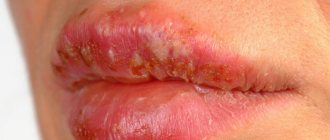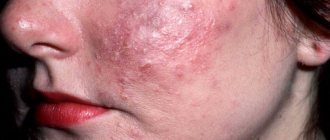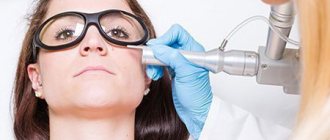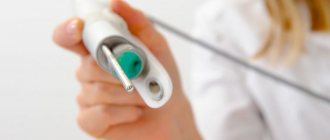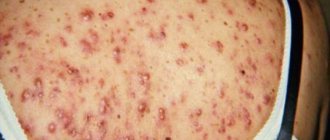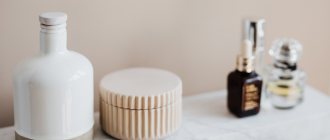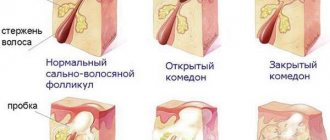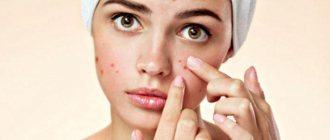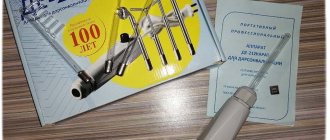The localization of a phenomenon such as a blood pimple can vary on the human body. Moreover, these can be either single neoplasms or numerous ones. In addition, such a rash is not always a pimple itself. So what could be the reasons for the appearance of rashes that are filled with blood, or at least that’s what they look like?
How do acne appear?
The elements of the rash localized on the skin of the face are varied. They arise as a result of inflammation in the sebaceous glands. The development of acne occurs in stages: the glands secrete an oily substance - sebum. It, along with dead cells, is removed from the ducts to the surface of the skin through the pores.
Sebaceous glands are associated with hair follicles. Due to the increased production of sebum, the excretory ducts cannot cope with cleansing, which leads to their clogging. In clogged canals, cysts - comedones - are formed, and a nutrient medium is created for the proliferation of microorganisms. Bacteria break down fat and its derivatives - fatty acids, damaging the skin and triggering the inflammatory process. This leads to the appearance of rashes on the face. The mechanism of development and structure of a pimple in cross-section can be seen in the figure.
Stages of pimple development
There are two types of comedones - closed and open. When completely blocked, comedones do not come to the surface, forming whiteheads.
Closed comedones (whiteheads)
With partial blockage, open comedones appear - blackheads. This happens because sebum is partially oxidized under the influence of oxygen, reacts with melanin, and the head of the comedone turns black (see photo below).
Open comedones (blackheads)
The collective name for inflammatory diseases of the sebaceous glands is acne. This term is often applied to acne and pimples.
Why cystic acne appears: on the face and body
As you can imagine, this type of rash is extremely unpleasant. Moreover, it is difficult to get rid of, and it leaves behind many traces. And, of course, many would like to understand what actually leads to its appearance. In this section, we will talk about the main factors that cause cystic acne and methods for their prevention.
As we said in the previous section, such acne appears when, due to an excess of sebum, the ducts through which this same sebum is excreted are clogged. Then, as a result of this, severe inflammation begins.
Therefore, it is worth understanding what can lead to the fact that the sebaceous glands begin to produce an excessive amount of secretion. Therefore, cystic acne on the face can appear due to such reasons.
Unusual hormonal activity
Most often, excess testosterone production is to blame. Because of it, the activity of the sebaceous glands is activated and pimples of this type appear. For adolescence, this phenomenon is considered absolutely normal, but adults should do a hormone test. Perhaps this will significantly help in treating the rash. It is worth understanding that if standard methods do not help you, then the problem is in your health. Most often it turns out that, after all, initially it was just hormones.
Dry skin
Seems contradictory, doesn't it? But in fact, we mean a situation where you regularly dry out normal, combination or oily skin. For example, incorrectly selected or too aggressive cosmetics. As a result, the epidermis reacts with increased secretion production. In fact, this is how the skin simply tries to protect itself from negative external influences. If the body believes that it is producing the right amount of sebum, it will try in every possible way to fight the fact that you are trying to dry out the epidermis.
Poor nutrition
It is believed that consuming large amounts of fatty foods provokes increased work of the sebaceous glands. There really isn't a lot of scientific work on this topic, but many people do notice that after they eat more fatty foods than usual, pimples appear on their skin.
These are just the most basic reasons. In fact, cystic acne can occur with any excess oil produced by the glands. And this can happen due to anything: illness, unhealthy lifestyle, stress and other things. But these factors affect the skin in this way quite rarely. In our list we only talked about the most common ones.
How can you prevent their occurrence?
So, now it’s worth talking about how to avoid all of the above. In fact, the most obvious option is to eat healthy, manage stress, take good care of your skin, and regularly check your hormones so that imbalances in production can be noticed and corrected in time. It sounds too simple, doesn't it? But in reality it is. Cystic acne is easier to prevent than acne such as rosacea, which is caused by specific bacteria. But treatment, oddly enough, is more difficult.
But on the other hand, what should teenagers do? It's not the fault of people who go through puberty that their hormones work the way they do. In this case, we can only recommend not to make mistakes. Try not to make the situation worse by trying to squeeze them out or dry them with alcohol. And if possible, you should go to a dermatologist.
Classification of acne according to inflammatory characteristics
The process of suppuration continues. Inflamed comedones form the following types of acne:
- Papules (nodules) are dense flat or cone-shaped formations with a diameter of 1-3 mm, slightly rising above the skin level. The color of acne varies from pale pink to red and bluish-purple. Swelling can be observed around the papule. The pus is located deep in the layers of the epidermis, so there is no inflamed white head on the surface. Papules are usually formed from closed comedones.
Papules
- Pustules are elements with purulent contents of a spherical, cone-shaped or flat shape. They are formed primarily (independently) or secondary - from papules. The diameter of pustules can range from 1 to 10 mm. On the surface of the formation, surrounded by a red rim, there is a white purulent head. The presence of yellowish or greenish tints indicates the addition of a secondary infection. When a pustule is injured, the walls of the blood vessels are destroyed and the pus mixes with the blood. It is not recommended to squeeze out the white head at home: there is a risk of infection of the open wound. Pustules can be dried with alcohol-containing and anti-inflammatory drugs (Zinerit, tea tree oil, boric alcohol).
Pustules
The outcome of the rash depends on the depth of damage to the layers of the dermis. In mild form, papulopustular elements heal without leaving marks. If the inflammation penetrates deeply and damages the skin structure, healing can occur with the formation of scars. You shouldn’t let the situation get worse, especially if the rashes multiply. In the absence of timely treatment, the clinical picture may change for the worse and lead to serious complications.
Treatment of acne vulgaris
- Sebostatic, antibacterial, anti-inflammatory drugs.
- Skin hygiene.
- For external therapy - topical retinoids, antibacterial drugs, combination drugs.
- Laser therapy, photodynamic therapy.
Treatment is prescribed only after confirmation of the diagnosis by a medical specialist.
Essential drugs
There are contraindications. Specialist consultation is required.
| 1 | Isotretinoin (Roaccutane) is a retinoid for systemic treatment of acne. |
Dosage: the drug is taken orally, during meals, 1-2 times a day. The effectiveness and side effects of the drug depend on the individual characteristics of the body and dosage. Therefore, it is necessary to adjust the dosage during treatment. The course of treatment with Roaccutane should begin with a dosage of 0.5 mg per kilogram of body weight per day. In most patients, the dosage ranges from 0.5 to 1.0 mg per kilogram of body weight per day. People with a complex form of the disease or acne of the trunk may need an increased daily dosage - up to 2.0 mg per kilogram per day. The frequency of remission and prevention of relapses are optimal when prescribing a course dose of 120-150 mg per kilogram, so the duration of the course in some patients varies depending on the daily dose. Complete remission of acne is often achieved within 16-24 weeks of therapy. Patients who do not tolerate the recommended dosage may continue treatment with a reduced dosage.
In most patients, acne completely disappears after one course of treatment. If a relapse occurs, a second course of Roaccutane therapy is prescribed with the same dosage as during the first course of treatment. Since the condition can improve up to 2 months after the patient stops taking the drug, a repeat course is prescribed no earlier than the end of this period.
| 2 | Adapalene (Differin) is a synthetic retinoid, a skin whitening agent. |
Dosage: the drug in the form of a cream or gel is applied in an equal layer to areas with skin lesions 1 time per day before bedtime. The drug is applied to clean, dry skin. The maximum effect is noticeable after 4-8 weeks of therapy, lasting improvement - after 3 months from the start of treatment.
| 3 | Benzoyl peroxide is an antimicrobial agent for the treatment of acne. |
Dosage: Before applying benzoyl peroxide gel or lotion, the affected area should be washed and dried with a soft-bristle towel. Next, the drug is applied to the affected area of the skin and rubbed in until completely absorbed. Be sure to wash your hands after use. If the skin is sensitive, the drug should be applied with extreme caution to avoid peeling and hypermia.
In the first week of the course, benzoyl peroxide is applied once a day; if the application does not produce results, benzoyl peroxide is applied 2 times a day. The use of the drug is not recommended for elderly people. The average duration of treatment with benzoyl peroxide is 8–10 weeks; It is not recommended to use the drug for more than 3 months.
In severe cases of the disease, topical use of benzoyl peroxide is combined with other acne treatments (oral antibiotics or retinoids).
| 4 | Loma Lux Acnemol is a homeopathic medicine for systemic treatment of acne and rosacea. |
Dosage: the drug is used orally, in the morning on an empty stomach, 1 time per day. The effectiveness of the drug depends on the individual characteristics of the body, the duration of administration and dosage. Therefore, the dosage is selected depending on weight, and the duration of the course depends on the degree of the disease and the rate of absorption of microelements. The initial and minimum course of treatment is 6 weeks, for rosacea - 8 weeks. Often the minimum course is sufficient. For moderate and severe stages, the course can be increased to 6 months in combination with external therapy. The drug is a homeopathic medicine based on macro- and microdoses of minerals. It has sebum-regulating, anti-inflammatory and keratolytic effects. The advantages of the drug include the absence of toxicity and compatibility with other types of therapy.
Severe forms of acne
In clinical practice, there are types of acne on the face with a severe inflammatory process. These include elements of the following types:
- nodular cystic;
- inductive;
- conglobate;
- fulminant;
- phlegmonous;
- necrotic.
Nodular-cystic acne is manifested by the formation of deeply recessed infiltrative elements and cavities filled with pus on the body and face. Large sebaceous plugs first transform into large (more than 1 cm) pimples, then they can grow into cysts, creating sebaceous passages under the skin. Healing is accompanied by a scarring process. Nodular cystic acne is painful and requires treatment under medical supervision, including surgery.
Indurative acne is the most common severe form of acne. They are compacted papular or papulopustular nodes with severe inflammation. Rashes occur in adolescence and occur against the background of increased sebum secretion. Deep nodes can unite into extensive clusters. Induration acne always leaves scars.
Conglobate (multiple, piled-up) pimples most often bother teenagers during puberty. This is a recurrent form of acne with a long course - up to several years. It is characterized by the fusion of comedones, as a result of which large spherical elements are formed deep in the dermis. The nodes are painful to the touch. At first they are dense, then soften and fill with purulent exudate. When conglobate acne heals, ulcers, fistulas, and rough hypertrophic scars can form.
Fulminant acne is a type of cystic acne with nodular purulent elements. It is more common in boys aged 13-16 years. Fulminant acne rashes occur suddenly, against the background of mild to moderate acne. Then they merge with each other, forming painful plaques covered with dirty, loose crusts. The ulceration in many cases ends with scarring.
Severe forms of acne on the face
Phlegmonous elements occur when inflammation develops in the deep layers of the epidermis, and small cavities containing pus are formed there. The surface of the skin is covered with small tubercles. Gradually they merge with each other, forming large crimson-red nodes. Subsequently, the mounds open in several places, and the purulent contents come out through the holes. Exudate is released in large quantities and contains blood.
Necrotic acne is characterized by rashes of pink or purplish-red nodules about the size of a pinhead. In the center of the acne, a pustular lesion forms, which, when dried, becomes covered with a bloody black crust. After the crust comes off, a depressed scar remains in place of the acne.
Severe forms of acne often last for years and are difficult to treat. Consultation with a dermatologist is required! The choice of drugs for treatment is determined by age, gender, advanced stage of the process, skin condition, test results, and the presence of concomitant diseases.
Types of acne depending on age and gender
Acne has its own characteristics in children, adolescents and adults. In particular, according to localization, acne in adolescents is located mainly in the T-zone (forehead, nose, upper part of the chin), and in adults in the U-zone (cheeks, around the mouth and lower part of the chin). The nature of the rash may also differ. In children and adolescents, comedones are almost always present, while in adult men and women they may be absent or present in small quantities. The inflammatory process is often more pronounced in adults. For more information about what to do if acne appears, read the article: “Acne - what tests to take, which doctor to see.”
Acne in children
1. Newborn acne
. Occurs in the first 3 weeks after birth due to a hormonal crisis caused by the influence of maternal hormones. They are characterized by a rash on the forehead, cheeks, chin in the form of comedones and rarely papules and pustules. Goes away on its own within 2 weeks.
2. Baby acne.
Appears at 6 weeks of age and can last up to 1 year. Boys are more susceptible than girls. Elements are more often on the face in the form of comedones, papules and pustules, nodes are very rare.
3. Acne of middle childhood.
Acne appears after 1 year and up to 7 years. It is very rare and may be a consequence of congenital adrenal hyperplasia, an androgen-producing tumor.
4. Pre-teenage (pre-adolescent) acne.
Acne appears after 7 years of age and indicates early puberty. It mainly affects the T-zone, rashes in the form of comedones, papules and pustules. Even after comedones, scars may remain.
Juvenile acne
With varying degrees of severity, juvenile acne occurs in almost all girls and boys. The first rashes can appear in boys from 12-14 years old, in girls from 11-13 years old. By age 24, acne either regresses or progresses to adult acne. At the age of 11-14 years, the comedonal form of acne predominates, and from 15-17 years, the papulopustular form predominates. After 17 years and up to 24 years, inflammatory forms of acne and nodular cystic acne predominate. Boys have a more severe course than girls.
Acne in adults
Acne in adults can be divided into 3 types:
- Persistent or persistent acne.
It first appears in adolescence and continues into adulthood.
— Late-onset acne.
Appears for the first time after 25 years.
In women, late acne includes premenstrual (2-7 days before) and postmenopausal acne. If late-onset acne appears, the woman should be examined for the presence of polycystic ovary syndrome, ovarian or adrenal tumors.
- Recurrent acne.
Juvenile acne resolved and there was a long period of remission for several years, and then acne reappeared.
There are also other types of acne that occur only in adults:
Acne inversa
occur with secondary damage to the apocrine sweat glands and mechanical impact. Localization - armpits, perineal area, navel, areola of the mammary glands. May be combined with increased body weight. It can occur in severe form with the formation of fistulas and cysts.
Bodybuilding acne
occur most often in men while taking anabolic steroids or when taking androgens. Characterized by the appearance of nodular toxic acne.
Necrotic acne (aspe necrotica)
can occur after 15 years and up to 40 years, have a chronic course. The localization area is the scalp, most often the frontal and frontotemporal areas. It manifests itself as vesiculopustular rashes, which open with the formation of erosion; upon healing, a smallpox-like atrophic scar appears.
Tropical eels (aspe trcpicalis)
occur in older people living in hot, humid climates. They manifest themselves as abscessing conglobate acne. Locations: back and buttocks.
Keloid acne (acne keloidalis)
characteristic of men, the disease lasts a long time and is resolved by sclerosis of the affected areas. Initially, pointed or flat papular rashes of pink color are diagnosed. Location: the back of the head and the border of the scalp.
Acne-tetrada
the most severe form of acne, which includes conglobate, inverse and abscess acne, Hoffmann's folliculitis undermines and complete or incomplete pilonidal sinus (a purulent cavity with a tuft of hair).
Artificial (mechanical)
acne occurs from friction and pressure with a tendency to develop acne. Inflammatory elements are localized in places of friction and compression, often at the border of the scalp and forehead from the cap, under the cast, on the back of the neck.
Cosmetic acne (acne cosmetica)
arise from cosmetic products with comedogenic effects. Fats and oils act as pathological agents: lanolin, petroleum jelly, some vegetable oils, tar. Frequent cases of cosmetic acne have been reported after using tanning oil. The rashes are localized in the areas where these cosmetics are applied.
Tags: acne
Market Analytics
- Black Lives Matter movement: reaction and consequences for the beauty industry
- COVID-19 is changing the rules of the game in the cosmetics market
- Beauty of the future: cosmetic innovations 2020
Convenient search for beauty salons on our website
Beauty salons in Moscow Beauty salons in St. Petersburg Beauty salons in Ekaterinburg Beauty salons in Novosibirsk
Latest blog posts on our website
- Naturecream / Tremella Extract - Snow Mushroom Detox for Skin
- Prostye-sovety / How to visually enlarge your lips with makeup
- Naturecream / Apricot kernel oil for face
- Naturecream / MATRIXYL3000 - the best skin elasticity stimulator
- Naturecream / SPF in Natural Oils
- Naturecream / Geranium (Pelargonium) oil for skin health and beauty
- Prostye-sovety / Save on a beauty salon: procedures that can be done at home
- Naturecream / Growth Factor - brings back youth?
- Oksana-Lezina / 3 effective abdominal exercises from a fitness instructor for beginners
- Prostye-sovety / Making perfect curls at home
Latest forum topics on our website
- Natalya / How to properly make a gelatin mask?
- Mrs._Smith / Badly sunburned! What to do?((
- Ice / Is it necessary to combine fitness classes with a diet?
- Antonova / What can be used for hair loss?
- Radio operatorKat / Who was on a protein diet?
Other articles in this section
| Acne - what tests to take, which doctor to see In this article we will look at what tests you need to take if you have acne, which doctor to see so that the correct treatment can be prescribed. |
| Pimples, blackheads and comedones in questions and answers. Part 2 The second part of a collection of frequently asked questions and answers about acne, compiled by American doctor Mark Lee. Causes of acne, methods of treating them, etc. |
| Pimples, blackheads and comedones in questions and answers. Part 1 The first part of a collection of frequently asked questions and answers about acne, compiled by American doctor Mark Lee. Causes of acne, methods of treating them, etc. |
| Acne (blackheads, pimples) - causes, diagnosis and treatment Acne (blackheads, pimples) or acne is a unique skin condition that has a large number of basic diagnostic signs: texture, skin color and discharge. The most obvious is the color due to inflammation. It is because of these signs that problems arise when it is not clear where to start treatment. |
| Using the Darsonval apparatus for acne Until recently, the Darsonval apparatus could only be found in cosmetic and physiotherapy rooms. The device copes well with pimples and advanced acne. Today, Darsonval is available for free sale. We will talk about the advantages and disadvantages of the device in the article. |
| Vitamins "Aevit" for acne - external and internal use "Aevit" is a combination of vitamins. The combination of beneficial substances allows you to achieve strengthened immunity and high antioxidant properties. The vitamin complex "Aevit", about which expert reviews are mostly positive, consists of the main components - tocopherol and retinol. |
| How to get rid of subcutaneous acne on the face In dermatology and cosmetology, more than 10 main methods are used to eliminate rashes that appear on the skin of the face. Independent removal of inflammatory elements located deep in the epithelium is dangerous due to the appearance of blue spots and scars. Therefore, it is better to contact a cosmetologist and jointly determine how to get rid of subcutaneous acne on the face. When choosing the optimal method, the type of neoplasm is taken into account - it has the form of a node, an abscess, a white or black dot. |
| Treatment of acne with sulfur Sulfur has been used for decades to combat acne of various origins. The component is popular due to its effectiveness and possibility of use for the treatment of sensitive skin. Usually, treating acne for people with this type of skin is a real problem: most medications cannot be used for fear of causing even more irritation. Sulfur soothes the skin and heals ulcers. |
| Hormones and their role in the development of acne When acne appears on the face, people say: “It's hormones playing naughty.” We cannot but agree with this statement, but let's try to dig deeper and figure out what the connection is between hormones and acne. |
| Acne with PMS or how the premenstrual cycle affects acne Are you familiar with this situation: as soon as your period approaches, acne inevitably appears on your flawless skin, and this happens again and again? Is premenstrual acne possible? |
Rashes other than acne
There are diseases accompanied by a rash that looks like acne. However, when acne forms, there are no comedones, and the appearance of rashes is due to other mechanisms. Such diseases are included in the group of acneiform dermatoses . These include perioral dermatitis, rosacea, rosacea, drug rash, skin tuberculosis, small nodular sarcoidosis and other ailments.
Acne-like rashes occur in some people after prolonged exposure to UV rays. This phenomenon is called “sun acne.” The disease becomes more active in the spring and summer. The appearance of sun rashes is completely identical to ordinary acne - these are small, dense papules of a reddish color. Pimples are predominantly located on the forehead, cheeks and chin, as well as exposed parts of the body.
Doctors also classify bodybuilding acne. The appearance of a rash is directly related to the use of steroid hormonal drugs. Their intake increases the secretion of sebum, as a result of which the skin becomes covered with nodular-cystic elements. Characteristic features of the rash: absence of comedones, monomorphism of the rashes and their rapid regression after discontinuation of steroids.
Acne vulgaris and dermatovenereology
If a person is tormented by acne vulgaris, then you need to consult a specialist. A beauty salon and standard cosmetic procedures performed by experts for acne will not be enough. Treating yourself at home, trying various folk recipes and medications without consulting a doctor is also a mistake.
A dermatovenerologist is a doctor who treats skin and venereal diseases and identifies the relationship between these diseases and the general condition of the body. It is a destructive and widespread belief that these doctors treat exclusively sexually transmitted diseases. If you are concerned about acne vulgaris, which is accompanied by disruptions in the menstrual cycle in women, and with urological problems in men, then be sure to visit a dermatovenerologist. He will prescribe a comprehensive examination that will reveal the underlying causes of the rash. Scraping, blood testing for allergens and harmful microorganisms, dermatoscopy, culture and smear - there are many methods for studying.
On a child's nose
Mostly, a child appears in this place due to infection and allergies. It is important to understand that as your child grows up, hormonal changes occur associated with changes in the body. This also means that the child has begun puberty.
If a child has a large pimple that doesn’t go away for a long time and hurts, most likely he has molluscum contagiosum, which needs to be removed. In order to quickly get rid of it, you should consult a doctor.
Acne on the right side occurs due to problems with the right parts of the liver, intestines, lungs, and kidneys. This indicates disruption of the functioning of organs in the relevant parts.

